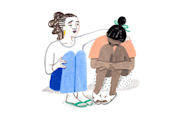If you're wondering:
What is a polyamory relationship?
What is polyamory vs polygamy?
What are the rules of polyamory?
You aren't the only one!
While multiple-person romantic and sexual relationships have been around for centuries in a range of cultures going back to ancient times, the word “polyamory” itself is fairly new.
The word polyamory first appeared in Green Egg Magazine in 1990. In the thirty years since, it has been added to the dictionary, discussed in celebrity interviews, and even documented on HGTV.
Yet many people are curious and unclear about what polyamory is and how polyamorous relationships actually work.
Read on and we'll share answers to questions about polyamory that you may have been too shy to ask.

1. What exactly is polyamory? And what is consensual non-monogamy (CNM)?
The specifics of polyamory can mean different things to different people, but at its core, polyamory is a form of consensual non-monogamy (CNM).
In CNM relationships, a couple agrees to engage in emotional and/or sexual relationships with other people while maintaining the current relationship.
Polyamorous relationships are different from other CNM relationships in that they emphasize engaging in multiple sexual and emotional relationships, rather than merely permitting it.
Consent, honesty, and responsibility are considered the pillars of polyamory.
2. What are the rules of polyamory? What does a polyamorous relationship look like? Is it all about sex?
As with any relationship, there is no one way a polyamorous relationship happens. Before entering a polyamorous relationship, participating individuals (polys) decide what works best for them and their relationship(s).
What’s best for one couple may be engaging only in other sexual relationships. And what’s best for another couple may be engaging only in other emotional relationships. Most polyamorous couples lie somewhere in between.
Many people assume polyamory means having sex with whomever you can, but it really focuses on forming multiple full relationships that fulfill each poly’s emotional and sexual needs. Sex is definitely part of the equation, but forming emotional connections is generally the priority.
The most common—or at least most visible—configuration is a couple, wherein both members have another partner or partners.
But polyamory is not a one-size-fits-all type of thing. It is up to polys themselves to determine the “rules” around who can engage in what kind of relationships when.
For instance, some polyamorous relationships allow space for the members to have multiple romantic pairings simultaneously. Others restrict romance to the primary relationship, but engage in sexual relationships with others.
Some polyamorous relationships involve both members of the primary relationship dating the same third person.
This list is by no means exhaustive–there are no set rules for how a polyamorous relationship should look, and therefore there are endless possibilities.
3. How common is polyamory?
It’s hard to gather data on how many people participate in polyamorous relationships because each relationship looks so different.
Not everyone involved in these relationships labels themselves as “polyamorous.”
However, a 2018 study found that 4% of individuals in North America take part in consensual non-monogamous relationships.

4. What’s the difference between polyamory and polygamy? What’s the difference between polyamory and open relationships?
Polygamy is a form of marriage specifically, and doesn’t apply to less institutionalized romantic and sexual relationships.
Unlike polyamory, polygamy is often closely tied with religion and demands that one individual has multiple spouses.
Open relationships are more closely linked to polyamory because they are both forms of CNM.
The main difference between polyamorous and open relationships is that polyamorous relationships include multiple simultaneous emotional and romantic relationships.
People often use “open relationships'' when talking about relationships where no explicit commitment has been made at all, or in situations where the relationships outside the primary couple are sexual only.
5. Is polyamory legal in the U.S.?
Yes. There are no laws against dating multiple people simultaneously. That said, there are laws prohibiting marriage between more than two people.
Only one city in the U.S. (Somerville, MA) recognizes polyamorous relationships as legal domestic partnerships. But everywhere else, because individuals cannot legally marry more than one person, polys don’t always receive the rights they would within a traditional marriage or domestic partnership.
6. Why are people polyamorous?
Since individuals have many differing sexual and romantic needs, some people believe that polyamory takes the pressure off of a traditional romantic relationship.
Polys believe they can better fulfill those needs by having multiple emotional and sexual relationships with different people.
Rather than relying on one person to be everything in a relationship, polys rely on different partners to meet different needs.
Polys believe that individuals have an infinite amount of love to give, so being with more than one person doesn’t invalidate any other feelings or relationships.
7. What if I want to try polyamory?
If you are in a relationship and want to try polyamory, you need to have an honest and direct conversation with your partner. It’s important to assure them that this doesn’t take away from your feelings for them, and that you want your partner to be comfortable with anything you both do.
Your partner may be unwilling or hesitant, so it’s important to focus the conversation on understanding one another and creating a relationship that makes you both happy.
Polyamory is one of many nontraditional relationship structures that is becoming more and more popular. To learn more about polyamory or find polyamorous communities near you, check out More Than Two and Loving More Nonprofit.
A Massachusetts City Decides to Recognize Polyamorous Relationships. (2020). The New York Times. Retrieved from https://www.nytimes.com/2020/07/01/us/somerville-polyamorous-domestic-partnership.html
Balzarini, R. N., Campbell, L., Kohut, T., Holmes, B. M., Lehmiller, J. J., Harman, J. J., & Atkins, N. (2017). Perceptions of primary and secondary relationships in polyamory. PLOS ONE, 12(5), e0177841. https://doi.org/10.1371/journal.pone.0177841
Bigger Love: Considerations for Polyamorous Clients | Levenfeld Pearlstein, LLC. (2020). Retrieved: https://www.lplegal.com/content/considerations-polyamorous-clients
Cunning Minx. (2016). Polyamory Weekly – FAQ: How to bring up polyamory within a monogamous relationship. Retrieved: http://polyweekly.com/faq-how-to-bring-up-polyamory-within-a-monogamous-relationship/
Fitzsimons, T. (2020). What’s a “throuple”? “House Hunters” episode puts polyamory on the radar. Retrieved: https://www.nbcnews.com/feature/nbc-out/what-s-throuple-house-hunters-episode-puts-polyamory-radar-n1137286
Introduction to Polyamory. (2020). Polyamory Society. Retrieved from: http://www.polyamorysociety.org/page6.html
Johnson, M. (2019, March 14). What Does It Mean to Be Polyamorous? Retrieved: https://www.healthline.com/health/polyamorous#1
Kramer, S. (2020). Polygamy is rare around the world and mostly confined to a few regions. Retrieved: https://www.pewresearch.org/fact-tank/2020/12/07/polygamy-is-rare-around-the-world-and-mostly-confined-to-a-few-regions/
López, C. (2020). 6 celebrities who have opened up about their polyamorous relationships - Insider. Retrieved: https://www.insider.com/celebrities-who-are-in-polyamorous-relationships-bella-thorne-jake-paul2019-1
Loving More Nonprofit a national 501c3 polyamory support organization. (2020). Retrieved: https://www.lovingmorenonprofit.org/
Oxford English Dictionary. (2020).: https://public.oed.com/updates/new-words-list-september-2006/
Sheff, E. (2012). Three Waves of Non-Monogamy: A Select History of Polyamory in the United States. Retrieved from: https://elisabethsheff.com/2012/09/09/three-waves-of-polyamory-a-select-history-of-non-monogamy/
Veaux, F. (2014). More Than Two | What, like, two girlfriends? Retrieved: https://www.morethantwo.com/polyamory.html
Veaux, F. (2021). More Than Two | Welcome to More Than Two. Retrieved: https://www.morethantwo.com/
Vincenty, S. (2019). Here’s How Polyamory Works. Retrieved: https://www.oprahmag.com/life/relationships-love/a29487304/polyamory-meaning/
Wood, J., Desmarais, S., Burleigh, T., & Milhausen, R. (2018). Reasons for sex and relational outcomes in consensually nonmonogamous and monogamous relationships. Journal of Social and Personal Relationships, 35(4), 632–654. https://doi.org/10.1177/0265407517743082
Zell, M. (1990). A Bouquet of Lovers: Strategies for Responsible Open Relationships. Green Egg XXIII(89). Retrieved from http://www.paganicon.org/wp-content/uploads/2014/03/A-Boquet-of-Lovers.pdf






